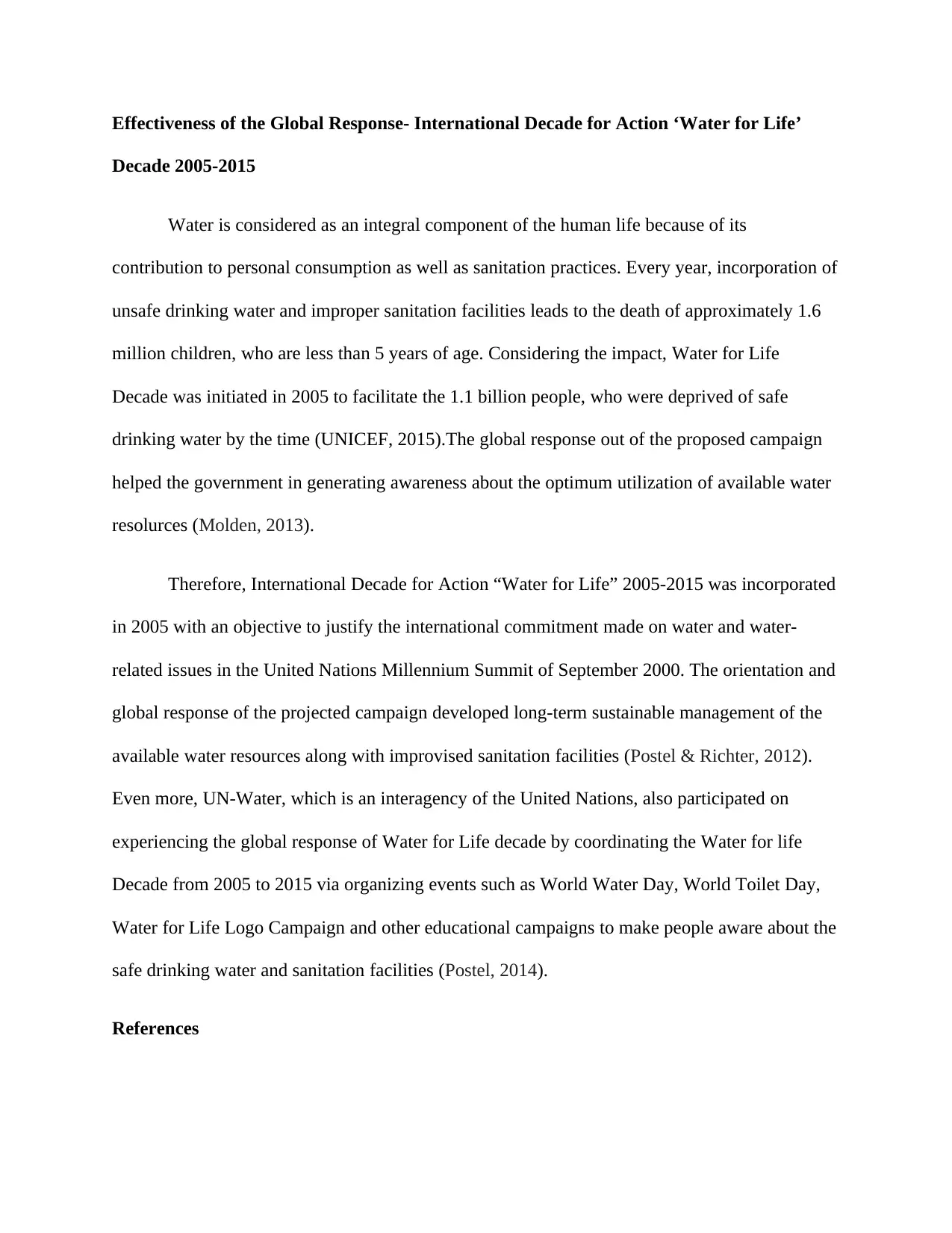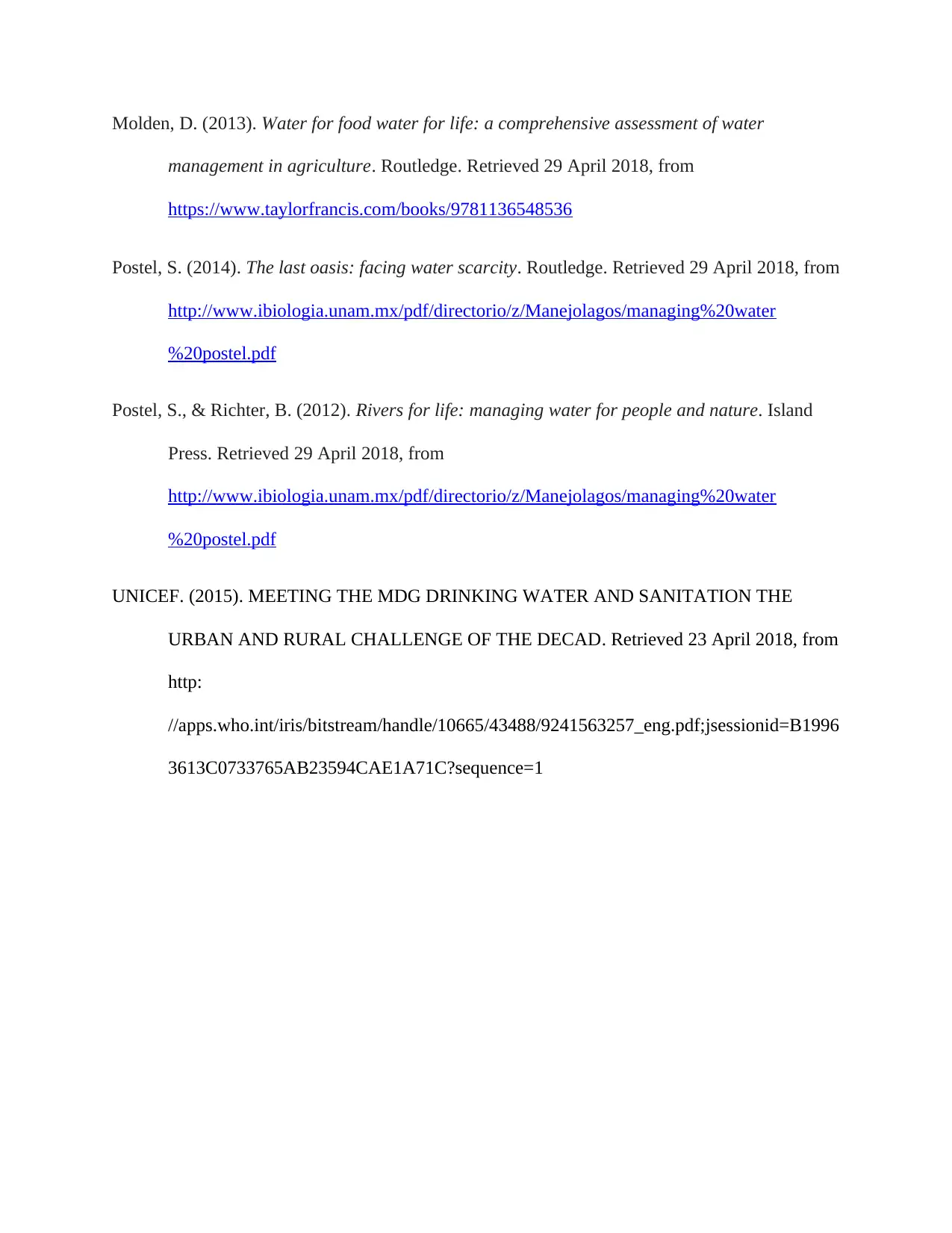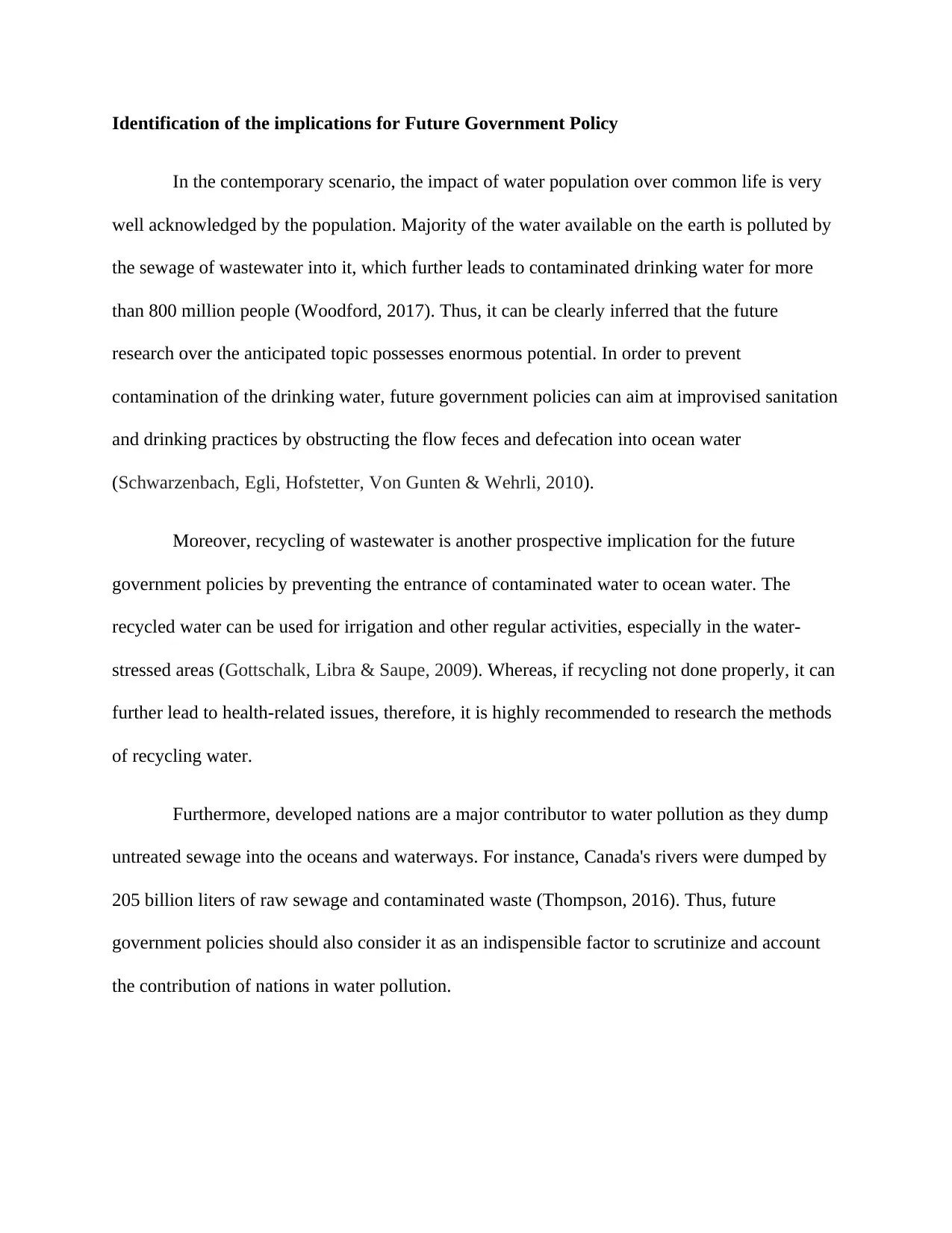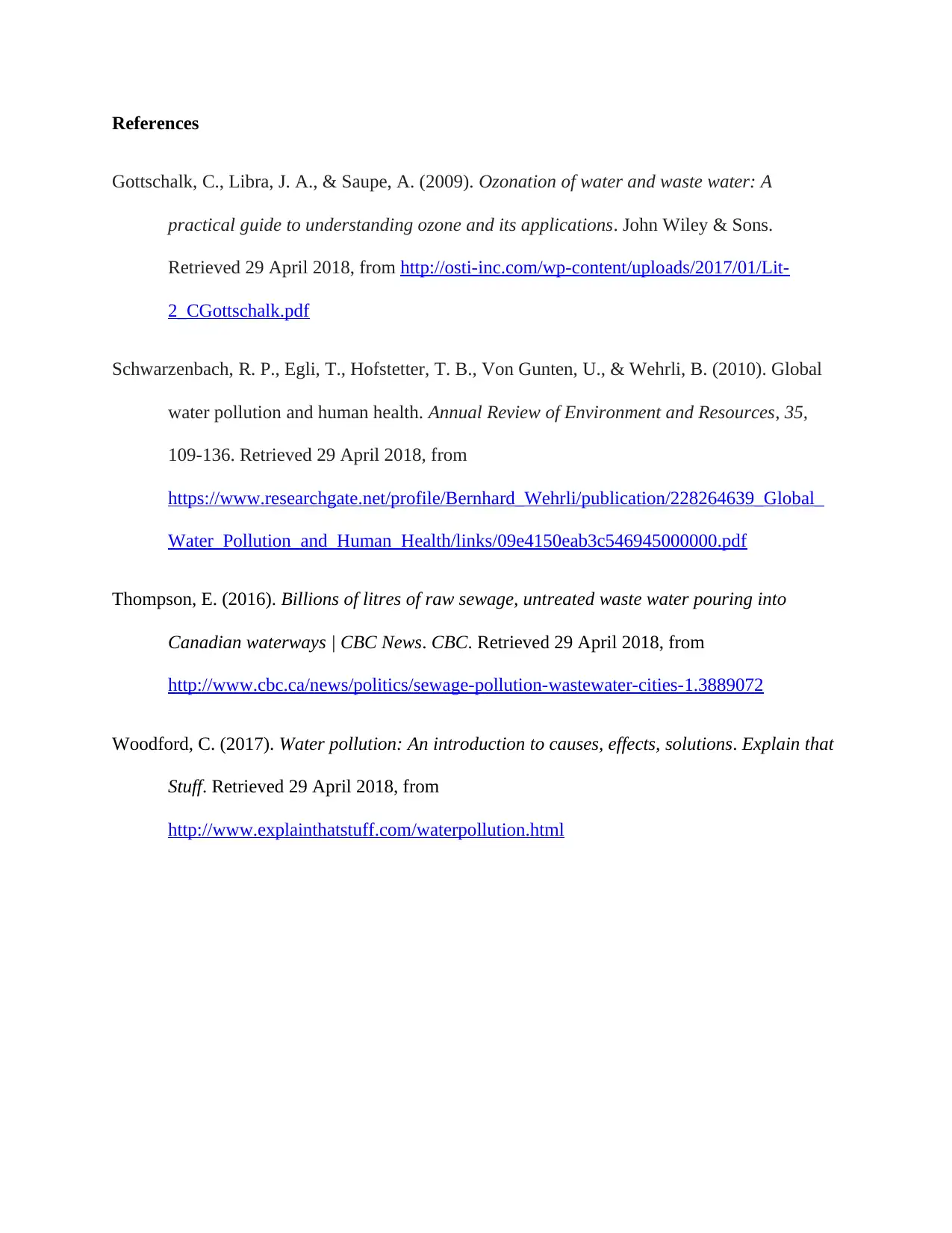Analyzing the Effectiveness of the Water for Life Decade (2005-2015)
VerifiedAdded on 2021/05/31
|4
|880
|33
Report
AI Summary
This report analyzes the effectiveness of the International Decade for Action 'Water for Life' (2005-2015), focusing on the global response to water-related issues. It examines the impact of the decade's initiatives on improving access to safe drinking water and sanitation, highlighting the role of government policies and awareness campaigns. The report identifies the challenges of water pollution, including sewage and wastewater contamination, and explores potential future government policies such as improved sanitation practices, wastewater recycling, and the scrutiny of nations' contributions to water pollution. The analysis references key publications and data sources to support its findings, offering insights into the long-term management of water resources and the implications for public health and environmental sustainability.

Effectiveness of the Global Response- International Decade for Action ‘Water for Life’
Decade 2005-2015
Water is considered as an integral component of the human life because of its
contribution to personal consumption as well as sanitation practices. Every year, incorporation of
unsafe drinking water and improper sanitation facilities leads to the death of approximately 1.6
million children, who are less than 5 years of age. Considering the impact, Water for Life
Decade was initiated in 2005 to facilitate the 1.1 billion people, who were deprived of safe
drinking water by the time (UNICEF, 2015).The global response out of the proposed campaign
helped the government in generating awareness about the optimum utilization of available water
resolurces (Molden, 2013).
Therefore, International Decade for Action “Water for Life” 2005-2015 was incorporated
in 2005 with an objective to justify the international commitment made on water and water-
related issues in the United Nations Millennium Summit of September 2000. The orientation and
global response of the projected campaign developed long-term sustainable management of the
available water resources along with improvised sanitation facilities (Postel & Richter, 2012).
Even more, UN-Water, which is an interagency of the United Nations, also participated on
experiencing the global response of Water for Life decade by coordinating the Water for life
Decade from 2005 to 2015 via organizing events such as World Water Day, World Toilet Day,
Water for Life Logo Campaign and other educational campaigns to make people aware about the
safe drinking water and sanitation facilities (Postel, 2014).
References
Decade 2005-2015
Water is considered as an integral component of the human life because of its
contribution to personal consumption as well as sanitation practices. Every year, incorporation of
unsafe drinking water and improper sanitation facilities leads to the death of approximately 1.6
million children, who are less than 5 years of age. Considering the impact, Water for Life
Decade was initiated in 2005 to facilitate the 1.1 billion people, who were deprived of safe
drinking water by the time (UNICEF, 2015).The global response out of the proposed campaign
helped the government in generating awareness about the optimum utilization of available water
resolurces (Molden, 2013).
Therefore, International Decade for Action “Water for Life” 2005-2015 was incorporated
in 2005 with an objective to justify the international commitment made on water and water-
related issues in the United Nations Millennium Summit of September 2000. The orientation and
global response of the projected campaign developed long-term sustainable management of the
available water resources along with improvised sanitation facilities (Postel & Richter, 2012).
Even more, UN-Water, which is an interagency of the United Nations, also participated on
experiencing the global response of Water for Life decade by coordinating the Water for life
Decade from 2005 to 2015 via organizing events such as World Water Day, World Toilet Day,
Water for Life Logo Campaign and other educational campaigns to make people aware about the
safe drinking water and sanitation facilities (Postel, 2014).
References
Paraphrase This Document
Need a fresh take? Get an instant paraphrase of this document with our AI Paraphraser

Molden, D. (2013). Water for food water for life: a comprehensive assessment of water
management in agriculture. Routledge. Retrieved 29 April 2018, from
https://www.taylorfrancis.com/books/9781136548536
Postel, S. (2014). The last oasis: facing water scarcity. Routledge. Retrieved 29 April 2018, from
http://www.ibiologia.unam.mx/pdf/directorio/z/Manejolagos/managing%20water
%20postel.pdf
Postel, S., & Richter, B. (2012). Rivers for life: managing water for people and nature. Island
Press. Retrieved 29 April 2018, from
http://www.ibiologia.unam.mx/pdf/directorio/z/Manejolagos/managing%20water
%20postel.pdf
UNICEF. (2015). MEETING THE MDG DRINKING WATER AND SANITATION THE
URBAN AND RURAL CHALLENGE OF THE DECAD. Retrieved 23 April 2018, from
http:
//apps.who.int/iris/bitstream/handle/10665/43488/9241563257_eng.pdf;jsessionid=B1996
3613C0733765AB23594CAE1A71C?sequence=1
management in agriculture. Routledge. Retrieved 29 April 2018, from
https://www.taylorfrancis.com/books/9781136548536
Postel, S. (2014). The last oasis: facing water scarcity. Routledge. Retrieved 29 April 2018, from
http://www.ibiologia.unam.mx/pdf/directorio/z/Manejolagos/managing%20water
%20postel.pdf
Postel, S., & Richter, B. (2012). Rivers for life: managing water for people and nature. Island
Press. Retrieved 29 April 2018, from
http://www.ibiologia.unam.mx/pdf/directorio/z/Manejolagos/managing%20water
%20postel.pdf
UNICEF. (2015). MEETING THE MDG DRINKING WATER AND SANITATION THE
URBAN AND RURAL CHALLENGE OF THE DECAD. Retrieved 23 April 2018, from
http:
//apps.who.int/iris/bitstream/handle/10665/43488/9241563257_eng.pdf;jsessionid=B1996
3613C0733765AB23594CAE1A71C?sequence=1

Identification of the implications for Future Government Policy
In the contemporary scenario, the impact of water population over common life is very
well acknowledged by the population. Majority of the water available on the earth is polluted by
the sewage of wastewater into it, which further leads to contaminated drinking water for more
than 800 million people (Woodford, 2017). Thus, it can be clearly inferred that the future
research over the anticipated topic possesses enormous potential. In order to prevent
contamination of the drinking water, future government policies can aim at improvised sanitation
and drinking practices by obstructing the flow feces and defecation into ocean water
(Schwarzenbach, Egli, Hofstetter, Von Gunten & Wehrli, 2010).
Moreover, recycling of wastewater is another prospective implication for the future
government policies by preventing the entrance of contaminated water to ocean water. The
recycled water can be used for irrigation and other regular activities, especially in the water-
stressed areas (Gottschalk, Libra & Saupe, 2009). Whereas, if recycling not done properly, it can
further lead to health-related issues, therefore, it is highly recommended to research the methods
of recycling water.
Furthermore, developed nations are a major contributor to water pollution as they dump
untreated sewage into the oceans and waterways. For instance, Canada's rivers were dumped by
205 billion liters of raw sewage and contaminated waste (Thompson, 2016). Thus, future
government policies should also consider it as an indispensible factor to scrutinize and account
the contribution of nations in water pollution.
In the contemporary scenario, the impact of water population over common life is very
well acknowledged by the population. Majority of the water available on the earth is polluted by
the sewage of wastewater into it, which further leads to contaminated drinking water for more
than 800 million people (Woodford, 2017). Thus, it can be clearly inferred that the future
research over the anticipated topic possesses enormous potential. In order to prevent
contamination of the drinking water, future government policies can aim at improvised sanitation
and drinking practices by obstructing the flow feces and defecation into ocean water
(Schwarzenbach, Egli, Hofstetter, Von Gunten & Wehrli, 2010).
Moreover, recycling of wastewater is another prospective implication for the future
government policies by preventing the entrance of contaminated water to ocean water. The
recycled water can be used for irrigation and other regular activities, especially in the water-
stressed areas (Gottschalk, Libra & Saupe, 2009). Whereas, if recycling not done properly, it can
further lead to health-related issues, therefore, it is highly recommended to research the methods
of recycling water.
Furthermore, developed nations are a major contributor to water pollution as they dump
untreated sewage into the oceans and waterways. For instance, Canada's rivers were dumped by
205 billion liters of raw sewage and contaminated waste (Thompson, 2016). Thus, future
government policies should also consider it as an indispensible factor to scrutinize and account
the contribution of nations in water pollution.
⊘ This is a preview!⊘
Do you want full access?
Subscribe today to unlock all pages.

Trusted by 1+ million students worldwide

References
Gottschalk, C., Libra, J. A., & Saupe, A. (2009). Ozonation of water and waste water: A
practical guide to understanding ozone and its applications. John Wiley & Sons.
Retrieved 29 April 2018, from http://osti-inc.com/wp-content/uploads/2017/01/Lit-
2_CGottschalk.pdf
Schwarzenbach, R. P., Egli, T., Hofstetter, T. B., Von Gunten, U., & Wehrli, B. (2010). Global
water pollution and human health. Annual Review of Environment and Resources, 35,
109-136. Retrieved 29 April 2018, from
https://www.researchgate.net/profile/Bernhard_Wehrli/publication/228264639_Global_
Water_Pollution_and_Human_Health/links/09e4150eab3c546945000000.pdf
Thompson, E. (2016). Billions of litres of raw sewage, untreated waste water pouring into
Canadian waterways | CBC News. CBC. Retrieved 29 April 2018, from
http://www.cbc.ca/news/politics/sewage-pollution-wastewater-cities-1.3889072
Woodford, C. (2017). Water pollution: An introduction to causes, effects, solutions. Explain that
Stuff. Retrieved 29 April 2018, from
http://www.explainthatstuff.com/waterpollution.html
Gottschalk, C., Libra, J. A., & Saupe, A. (2009). Ozonation of water and waste water: A
practical guide to understanding ozone and its applications. John Wiley & Sons.
Retrieved 29 April 2018, from http://osti-inc.com/wp-content/uploads/2017/01/Lit-
2_CGottschalk.pdf
Schwarzenbach, R. P., Egli, T., Hofstetter, T. B., Von Gunten, U., & Wehrli, B. (2010). Global
water pollution and human health. Annual Review of Environment and Resources, 35,
109-136. Retrieved 29 April 2018, from
https://www.researchgate.net/profile/Bernhard_Wehrli/publication/228264639_Global_
Water_Pollution_and_Human_Health/links/09e4150eab3c546945000000.pdf
Thompson, E. (2016). Billions of litres of raw sewage, untreated waste water pouring into
Canadian waterways | CBC News. CBC. Retrieved 29 April 2018, from
http://www.cbc.ca/news/politics/sewage-pollution-wastewater-cities-1.3889072
Woodford, C. (2017). Water pollution: An introduction to causes, effects, solutions. Explain that
Stuff. Retrieved 29 April 2018, from
http://www.explainthatstuff.com/waterpollution.html
1 out of 4
Your All-in-One AI-Powered Toolkit for Academic Success.
+13062052269
info@desklib.com
Available 24*7 on WhatsApp / Email
![[object Object]](/_next/static/media/star-bottom.7253800d.svg)
Unlock your academic potential
Copyright © 2020–2025 A2Z Services. All Rights Reserved. Developed and managed by ZUCOL.